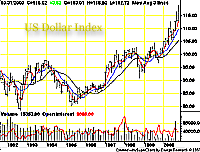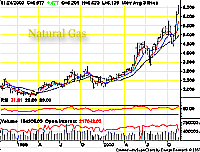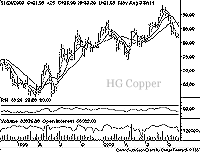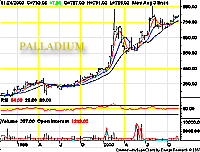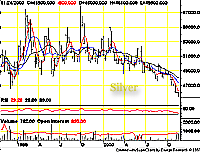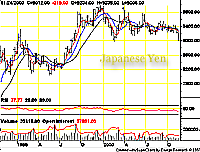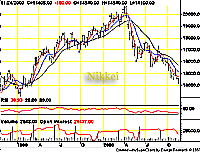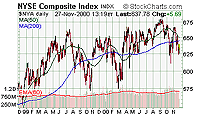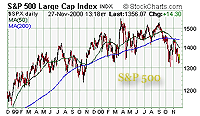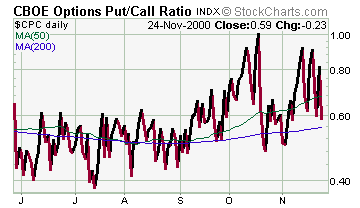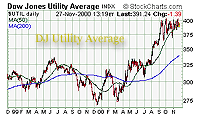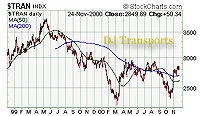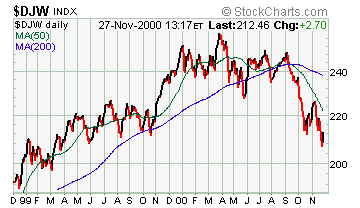Turkeys Cannot Fly Always-look-on-the-bright-side-of-life…
Sure, but which side is going to shine next year and the year after, the dollar bulls or commodity bulls? Or is it dollar bulls vs. dollar bears, or commodity bulls vs. commodity bears? Both want to see the Fed lower interest rates, but that is about as far as their interests converge before facing reality, which is that their interests are as mutually exclusive as those of two Siamese fighting fish in one small fish tank. The basic reason is that both of their values are relative to one another. The
Theory of Relativity
I am showing you only a few here, but there are a decisive majority of agricultural commodities, which have risen strongly relative to the US dollar this year. The Goldman Sachs Agricultural Index for instance, which we showed recently, is looking more bullish not less. All of the energy markets (except for unleaded gasoline) are without a doubt blazing a bullish trail, with natural gas prices in a virtual vertical ascent, rising 30% so far this month alone. Metals markets are mixed, but overall they have mostly pulled back this fall. Yet except for Gold and silver prices (whose declining prices have effectively sterilized the incredible rise of the other precious metals, platinum and palladium), most of them are generally rising at a solid clip for most of this year. Palladium prices, in particular, look set to fire off into another universe, while silver prices depict the steepening slope of Angel Falls.
The point is that neither the alleged productivity gains in the tech sector (and agriculture industry) nor the incredibly rising global dollar "exchange rate" are broadly suppressing prices any longer. That's not good for a dollar buying cycle, which works well when there is little dollar inflation, but not too well when the dollar cannot hold its value against important world commodities. So if the dollar has trouble holding its "objective" value, why would foreign investors continue to hold or buy more dollars? The fact that Europe needs to buy dollars in order to buy OPEC oil underscores the mechanisms that the Treasury has in place to automatically fight (I should say hide) any possible dollar inflation. But the use of these mechanisms is really at the sellers' discretion. In other words, when OPEC decides it is no longer in its interest to accept dollars for its oil, the dollar might have trouble hanging on to its more "subjective" international values (utilities) as well. In fact, it seems that even Venezuela is going to be pushing for Euros, or at least that has been the talk ever since their oil minister made OPEC secretary general/treasurer. Should they get their wish, which no one on this continent seems to expect that they will, a not insignificant pillar of dollar support will have been weakened. We haven't been able to find much "official" European opinion on the matter so far, only the odd acknowledgement that there is no oil shortage on world markets (implying a dollar problem). However, there is no surprise there, as we know all too well how sensitive financial markets can be to a true political statement. Yet still, dollar bulls claim that however bad the dollar situation is, the Euro and Yen situation is worse. Because
The Other Currencies Are Even Worse Off But let's be a little bit more realistic here and have a look at what is really happening in the forex market. It
could be that the Euro is ready to roll Assume for a moment that the world's leaders are dutifully aware of the existential aspects of the current relative structure of the global currency regime, meaning that they know that they have to keep this structure intact over the long term to avoid a reversion to a gold standard. Is this a fair assumption? It is a safe one… never underestimate the intelligence of the market's puppet masters. Anyhow, considering such an assumption it isn't too difficult to see how the Fed and the Treasury will have to concede at least a temporary Euro victory, if only to preserve the global currency infrastructure. Accordingly, it is not surprising that when Wim Duisenberg spoke at a private luncheon on Nov 17th in Amsterdam that he sounded a lot like Mr. Greenspan. While espousing the virtue of monetary discipline on the one hand, he tried hard to justify the more cloudy "discretionary" components of the ECB's monetary policy strategy. Nonetheless, it was gratifying to see that the ECB keeps as its first priority a check on the growth in monetary aggregates, by anchoring such growth to an arbitrary reference value (a growth rate of 4.5% in M3 is apparently acceptable). But it is still disappointing to see that more weight in reality is placed on the second pillar of policy, the discretionary process, which has allowed M3 to already grow at over 5% since inception in 1999. Though it has recently moderated to 3.6% in September. The discretionary process of course has plenty of legitimate justification as always, such as the flexibility necessary for a new currency in a complex and rapidly changing economic environment, which involves the merging of 11 different nations and/or economies. But perhaps the most familiar words spoken were when he cautioned his audience about reading too much in the higher than normal HICP (consumer prices) rate of 2.8% in September as certain "temporary external" factors are occurring in energy markets and in exchange rate markets, which monetary policy cannot counteract. Since we know that is a lie, we now know that the ECB will have the support of the Fed on the next currency intervention! Where
does the Yen fit? It is interesting to watch the dollar gain momentum even as economic growth rates converge around the world. In such an environment, it is difficult to properly explain the dollar's increasing parabolic trajectory, especially when this meteoric rise in value against other paper (fiat) currencies lags the rise in value of commodities relative to the global (fiat) purchasing power of the dollar.
But perhaps this might have something more to do with recent dollar/yen strength, or if not, at least might explain recent Yen weakness... the Bank for International Settlements reported that Japanese Banks' cross border lending totaled $52 billion (dollars) in the second quarter. That figure is up 75% compared with the same quarter one year ago and it is only 5% below the amount of capital, which Japanese banks exported in all of 1999. That's a lot of dollars. The Japanese thus continue to export capital at a rate, which is equal to a little more than half of the US trade deficit. By the way, this figure does not mean that all of that money went to US markets. But it is also an old figure, which may not yet reflect the accelerated rate of growth evident in the issuances of so-called Samurai bonds (bonds issued to foreigners, denominated in Yen) since the second quarter. Although analysts are concerned that Japanese investors will stop purchasing these bonds from foreigners after the HITIC default and the Xerox uncertainty, the fact remains that issuances are in record territory, for the moment. In 1999, a total of about $6 billion in Samurai bonds was issued. So far this year, that number has tripled to roughly $18 billion, but half of that was issued since only the end of the second quarter (we should be quoting this in yen, but chose to keep it simple - for our own benefit). We do fully expect this demand to ebb, particularly if there are other defaults, but it is unlikely to ebb tomorrow if nearby expectations for a strong dollar continue. The Japan Times made the following comment over the weekend:
So with comments like that coming from Japanese investment dealers, it is difficult to perceive that the demand has ebbed quite yet. But it is equally difficult to perceive that the demand for US debt in particular can grow much more beyond this point. Accordingly, we find little reason for a sustained Yen decline, particularly if the Bank of Japan stays on its current course for tougher interest rates. Another
Buying Opportunity? You see, up until then, NYSE bulls have been busy trying to maintain a pretty sequence of higher highs and higher lows, which they started in mid October. But Wednesday's lower low the day before an American holiday, which is statistically bullish for stocks by the way, followed new lows in the tech heavy ND and lower lows in the S&P 500. The moves threw a bearish bias into the charts, working the bears up for yet another plunge at October's lows, and very possibly beyond.
But rather than resting its full tummy the day after, the shrewd bull found yet another buying opportunity too irresistible to ignore. Besides, after a decent close in Tokyo and in European tech markets earlier in the US session, loading up on even more allegedly oversold tech issues seemed like the right thing to do. Friday's three best Dow performers were Intel +6.7%, Hewlett-Packard +5.6%, and AT&T +3.34%. Monday is going to have to be a decisive day for the bulls because Friday's bounce was not a rally. Twelve months ago, such a bounce at such a point would have turned into a ferocious bull assault on bearish strongholds, in a rally about three or four times as powerful as the bounce on Friday. Lest we get too tough on the bulls though, we suspect that most of them weren't all that worried about the week's action. For at least it didn't show up in the put / call ratio, which implies about the same degree of bullishness that existed in early November... just before the Dow and the Nasdaq got nailed for 600 points.
So, are the options markets predicting a rally or are they telling us that there is too much complacency for a rally to develop? Normally it would be the latter and we see no reason why that shouldn't be the case going into this week. The Dow Utilities started the week off at new highs as oil prices remained generally sticky and the media gradually warmed up to the potentially bullish energy story as we thought that they might when we wrote our thesis... Wall Street Kisses Goldilocks Goodbye. Though they fell back by Friday, in sympathy of the Thanksgiving bear raid this year... turkeys. Meanwhile, the Dow Transports have been acting up lately and we find it difficult to explain. Apparently, higher oil prices haven't drowned out bullish noise about expected growth in the travel industry.
So the call is out to bulls everywhere... they had better show up to the ball game this week, for if this thing isn't gonna bounce here and now it will have to bounce off of a lower level. For, the path of least resistance in the rest of the market is increasingly toward lower lows / lower highs... for almost all stocks.
The Dow Jones World Stock Average bounced around important support for most of the week and closed down 2.3%, but closer to the high end of the week's range than the low end. Nevertheless, it was representative of the global stock market scene on the week; at least in US and European equities... hum drum, quiet, but perhaps telling... have the worst news and more pessimistic expectations been discounted? You might think so by glancing at the extent of the markets declines so far this year, but it is never wise to take a contrarian position when sentiment indicators still reflect tons of bullishness. Dear
Mr. Soros In the article, Mr. Jackson, a well-read economic historian, replied to Soros' attack on the free market system and of it threatening democracy, correctly accusing him of ignorant economics. I will not spend time on the argument, but have provided the link for your own interest... just click on the title of the article above. As we all know, Mr. Soros strongly believes that financial markets are inherently unstable. Extrapolating such a view, it isn't difficult to reach statist, socialist, or communist conclusions on the topic of individualism and market mechanisms, but I am amazed at who it comes from. What ever happened to his supposed understanding of economics? That is less important, however, than perhaps the fact that his view of free markets (he is publishing a new book by the way) may be increasingly and frighteningly representative of today's leaders. Now I re read this article because I was dumfounded by comments that he made in a recent interview last week, where he claimed that the condition of rapidly vanishing savings rates can go on for some time, that the government's bourses are well intact due to the US fiscal budget surplus, there is no inflation, and that the dollar will stay strong because foreign interests are all on side. Combined with his critique of the ECB's monetary policies, I don't know if he is lying because he is short the dollar or because he has become an agent of the US Treasury (part of the establishment, so to speak). Anyway, the part of the Gerard Jackson article, which I found particularly interesting and goes right to the heart of Soros ignorance (or agenda) is this:
Well said! Now, please refer to the two charts at the beginning of the report and remember that it is both, in the interests of "today's" dollar bulls (or so they think) as well as it is in the interests of today's commodity bulls (dollar bears), to see to it that the Fed will lower interest rates soon. But the fact remains that it is in the Fed's interest to raise interest rates high enough to prevent the inflation from spreading, now, while inflation expectations are still in check. In our opinion, this is true whether it is acknowledged or not. Unfortunately, Mr. Greenspan and company cannot afford to do what they must to ensure the survival of the Federal Reserve System, for it has got to be difficult for the man of the decade to put everyone out of work in order to "prevent" the otherwise inevitable currency / economic collapse. Conclusion Sincerely,
The GoldenBar Global Investment Climate is not a registered advisory service and does not give investment advice. Our comments are an expression of opinion only and should not be construed in any manner whatsoever as recommendations to buy or sell a stock, option, future, bond, commodity or any other financial instrument at any time. While we believe our statements to be true, they always depend on the reliability of our own credible sources. Of course, we recommend that you consult with a qualified investment advisor, one licensed by appropriate regulatory agencies in your legal jurisdiction, before making any investment decisions, and barring that, we encourage you to confirm the facts on your own before making important investment commitments. |
||||||||||||||||||||||||||

